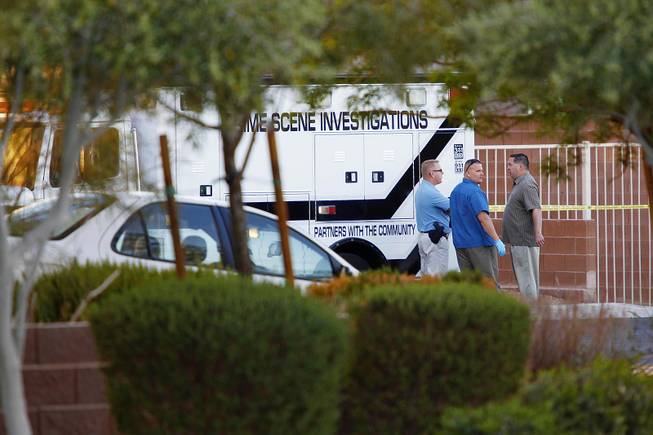
Sam Morris / Las Vegas Sun
Metro police stand near a crime scene investigation truck near the site of a double-homicide and suicide Friday, April 19, 2013, in the Mountain’s Edge development in the southwest part of the valley.
Sunday, Sept. 21, 2014 | 2 a.m.
Metro Police fear more than 130 people could be killed in Las Vegas by the year’s end if homicides continue at the current pace.
Eleven people, on average, have died as homicide victims each month this year, said Capt. Csaba Maczala, who oversees Metro’s robbery and homicide bureau. Homicides are up nearly 20 percent compared with last year, according to department data.
Metro detectives on Sept. 15 opened their 93rd case of the year — a fatal shooting in a strip mall parking lot near UNLV, which, like 59 percent of other homicides this year, involved a gun.
“I wish we didn’t have such volume of violence in this community,” Maczala said. “There are great people who live here.”
In 2006, the number of homicides in Las Vegas reached 157, the highest count recorded in the city. By 2012, the tally had fallen to 84 but slowly began to rise again. Last year, Metro recorded 105 homicides.
It’s not just gun violence leading to more killings. Twenty-three percent of the homicides this year were related to domestic violence, with the majority of suspects being men, Maczala said.
That trend is nothing new. For nine of the past 10 years, Nevada has ranked in the top 10 states nationally for the rate of women killed by men, according to the Violence Policy Center. This year’s report, based on 2012 data, ranked Nevada No. 6 in women killed by men.
What did surprise Metro officials was that many of the women killed had more prior arrests for domestic violence than the men suspected of killing them, Maczala said.
Even so, authorities can’t pinpoint a specific population that’s more at risk for homicide. Suspects and victims cross all races, ages, genders and ethnicities.
Department leaders rely heavily on what they call a “firearms density map” to predict where homicides might occur. The maps, updated weekly, show officers where most violent crime — assaults, robberies and shootings — have occurred, so they can adjust resources accordingly, Maczala said.
But it’s nowhere near an exact science. Many killings result from a single heated argument.
To try to prevent such violence, Metro is hosting its first Homicide Awareness and Prevention Symposium on Oct. 16. The goal is to gather social-service providers, judges, counselors, faith leaders and military representatives to brainstorm ways to identify early signs of violence and intervene.
“My homicide detectives respond after the fact,” Maczala said. “We’ve already lost the battle, because there’s another dead body there. Our best bet is to get the community involved.”
Metro detectives have arrested suspects for about 65 percent of the homicide cases this year, Maczala said. Another 17 percent are open cases with leads.

Join the Discussion:
Check this out for a full explanation of our conversion to the LiveFyre commenting system and instructions on how to sign up for an account.
Full comments policy